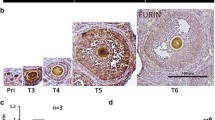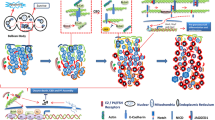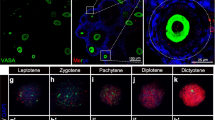Abstract
Mammalian female fertility relies on the proper development of follicles. Right after birth in the mouse, oocytes associate with somatic ovarian cells to form follicles. These follicles grow during the adult lifetime to produce viable gametes. In this study, we analyzed the role of the ATM and rad3-related (ATR) kinase in mouse oogenesis and folliculogenesis using a hypomorphic mutation of the Atr gene (Murga et al. 2009). Female mice homozygotes for this allele have been reported to be sterile. Our data show that female meiotic prophase is not grossly altered when ATR levels are reduced. However, follicle development is substantially compromised, since Atr mutant ovaries present a decrease of growing follicles. Comprehensive analysis of follicular cell death and proliferation suggest that wild-type levels of ATR are required to achieve optimal follicular development. Altogether, these findings suggest that reduced ATR expression causes sterility due to defects in follicular progression rather than in meiotic recombination. We discuss the implications of these findings for the use of ATR inhibitors such as anti-cancer drugs and its possible side-effects on female fertility.




Similar content being viewed by others
References
Baker SM, Plug AW, Prolla TA, Bronner CE, Harris AC, Yao X, Christie DM, Monell C, Arnheim N, Bradley A, Ashley T, Liskay RM (1996) Involvement of mouse Mlh1 in DNA mismatch repair and meiotic crossing over. Nat Genet 13:336–342
Blackford AN, Jackson SP (2017) ATM, ATR, and DNA-PK: the trinity at the heart of the DNA damage response. Mol Cell 66:801–817. https://doi.org/10.1016/j.molcel.2017.05.015
Brown EJ, Baltimore D (2000) ATR disruption leads to chromosomal fragmentation and early embryonic lethality. Genes Dev 14:397–402
Cimprich KA, Cortez D (2008) ATR: an essential regulator of genome integrity. Nat Rev Mol Cell Biol 9:616–627. https://doi.org/10.1038/nrm2450
Cole F, Kauppi L, Lange J, Roig I, Wang R, Keeney S, Jasin M (2012) Homeostatic control of recombination is implemented progressively in mouse meiosis. Nat Cell Biol 14:424–430. https://doi.org/10.1038/ncb2451;10.1038/ncb2451
Edelmann W, Cohen PE, Kane M, Lau K, Morrow B, Bennett S, Umar A, Kunkel T, Cattoretti G, Chaganti R, Pollard JW, Kolodner RD, Kucherlapati R (1996) Meiotic pachytene arrest in MLH1-deficient mice. Cell 85:1125–1134. https://doi.org/10.1016/S0092-8674(00)81312-4
Karnitz LM, Zou L (2015) Molecular pathways: targeting ATR in cancer therapy. Clin Cancer Res 21:4780–4785
Kerr JB, Myers M, Anderson RA (2013) The dynamics of the primordial follicle reserve. Reproduction 146:R205–R215. https://doi.org/10.1530/REP-13-0181
Lecona E, Fernández-Capetillo O (2014) Replication stress and cancer: it takes two to tango. Exp Cell Res 329:26–34. https://doi.org/10.1016/j.yexcr.2014.09.019
Li R, Albertini DF (2013) The road to maturation: somatic cell interaction and self-organization of the mammalian oocyte. Nat Rev Mol Cell Biol 14:141–152. https://doi.org/10.1038/nrm3531
Liu Y-X (2007) Interaction and signal transduction between oocyte and somatic cells in the ovary. Front Biosci 12:2782–2796
Morelli MA, Cohen PE (2005) Not all germ cells are created equal: aspects of sexual dimorphism in mammalian meiosis. Reproduction 130:761–781
Murga M, Bunting S, Montana MF, Soria R, Mulero F, Canamero M, Lee Y, McKinnon PJ, Nussenzweig A, Fernandez-Capetillo O (2009) A mouse model of ATR-Seckel shows embryonic replicative stress and accelerated aging. Nat Genet 41:891–898
Murga M, Campaner S, Lopez-Contreras AJ, Toledo LI, Soria R, Montana MF, D’Artista L, Schleker T, Guerra C, Garcia E, Barbacid M, Hidalgo M, Amati B, Fernandez-Capetillo O (2011) Exploiting oncogene-induced replicative stress for the selective killing of Myc-driven tumors. Nat Struct Mol Biol 18:1331–1335. https://doi.org/10.1038/nsmb.2189;10.1038/nsmb.2189
Nam EA, Cortez D (2011) ATR signalling: more than meeting at the fork. Biochem J 436:527–536. https://doi.org/10.1042/BJ20102162
O’Driscoll M (2009) Mouse models for ATR deficiency. DNA Repair (Amst) 8:1333–1337. https://doi.org/10.1016/j.dnarep.2009.09.001
Pacheco S, Maldonado-Linares A, Marcet-Ortega M, Rojas C, Martínez-Marchal A, Fuentes-Lazaro J, Lange J, Jasin M, Keeney S, Fernández-Capetillo O, Garcia-Caldés M, Roig I (2018) ATR is required to complete meiotic recombination in mice. Nat Commun 9:2622. https://doi.org/10.1038/s41467-018-04851-z
Pelosi E, Forabosco A, Schlessinger D (2015) Genetics of the ovarian reserve. Front Genet 6:308. https://doi.org/10.3389/fgene.2015.00308
Roig I, Liebe B, Egozcue J, Cabero L, Garcia M, Scherthan H (2004) Female-specific features of recombinational double-stranded DNA repair in relation to synapsis and telomere dynamics in human oocytes. Chromosoma 113:22–33. https://doi.org/10.1007/s00412-004-0290-8
Sánchez F, Smitz J (2012) Molecular control of oogenesis. Biochim Biophys Acta Mol basis Dis 1822:1896–1912. https://doi.org/10.1016/j.bbadis.2012.05.013
Sørensen CS, Hansen LT, Dziegielewski J, Syljuåsen RG, Lundin C, Bartek J, Helleday T (2005) The cell-cycle checkpoint kinase Chk1 is required for mammalian homologous recombination repair. Nat Cell Biol 7:195–201. https://doi.org/10.1038/ncb1212
Toledo L, Neelsen KJ, Lukas J, 2017. Perspective replication catastrophe: when a checkpoint fails because of exhaustion. doi:https://doi.org/10.1016/j.molcel.2017.05.001
Toledo LI, Murga M, Fernandez-Capetillo O (2011) Targeting ATR and Chk1 kinases for cancer treatment: a new model for new (and old) drugs. Mol Oncol 5:368–373. https://doi.org/10.1016/j.molonc.2011.07.002;10.1016/j.molonc.2011.07.002
van den Hurk R, Zhao J (2005) Formation of mammalian oocytes and their growth, differentiation and maturation within ovarian follicles. Theriogenology 63:1717–1751. https://doi.org/10.1016/j.theriogenology.2004.08.005
Weber AM, Ryan AJ (2015) ATM and ATR as therapeutic targets in cancer. Pharmacol Ther 149:124–138. https://doi.org/10.1016/j.pharmthera.2014.12.001
Widger A, Mahadevaiah SK, Lange J, ElInati E, Zohren J, Hirota T, Pacheco S, Maldonado-Linares A, Stanzione M, Ojarikre O, Maciulyte V, de Rooij DG, Tóth A, Roig I, Keeney S, Turner JMA (2018) ATR is a multifunctional regulator of male mouse meiosis. Nat Commun 9:2621. https://doi.org/10.1038/s41467-018-04850-0
Woodard TL, Bolcun-Filas E (2016) Prolonging reproductive life after cancer: the need for fertoprotective therapies. Trends Cancer 2:222–233. https://doi.org/10.1016/j.trecan.2016.03.006
Zhang H, Risal S, Gorre N, Busayavalasa K, Li X, Shen Y, Bosbach B, Brännström M, Liu K (2014) Somatic cells initiate primordial follicle activation and govern the development of dormant oocytes in mice. Curr Biol 24:2501–2508. https://doi.org/10.1016/j.cub.2014.09.023
Zhang Y, Yan Z, Qin Q, Nisenblat V, Chang H-M, Yu Y, Wang T, Lu C, Yang M, Yang S, Yao Y, Zhu X, Xia X, Dang Y, Ren Y, Yuan P, Li R, Liu P, Guo H, Han J, He H, Zhang K, Wang Y, Wu Y, Li M, Qiao J, Yan J, Yan L (2018) Transcriptome landscape of human folliculogenesis reveals oocyte and granulosa cell interactions. Mol Cell 72:1021–1034.e4. https://doi.org/10.1016/j.molcel.2018.10.029
Zou L, Elledge SJ (2003) Sensing DNA damage through ATRIP recognition of RPA-ssDNA complexes. Science (80-) 300:1542–1548. https://doi.org/10.1126/science.1083430
Acknowledgements
We wish to thank O. Fernández-Capetillo (CNIO, Spain) for providing us with the Seckel allele.
Funding
This work was supported by the Ministerio de Ciencia e Innovación (BFU2010-18965, BFU2013-43965-P and BFU2016-80370-P, IR) and by the UAB-Aposta award to young investigators (APOSTA2011-03, IR).
Author information
Authors and Affiliations
Corresponding author
Ethics declarations
Experimental procedures performed in the present work conform to protocol CEEAAH 1091 (DAAM6395) approved by the Ethics Committee for Animal Experimentation of the Universitat Autònoma de Barcelona and the Catalan Government.
Additional information
Publisher’s note
Springer Nature remains neutral with regard to jurisdictional claims in published maps and institutional affiliations.
This article is part of a Special Issue on Recent advances in meiosis from DNA replication to chromosome segregation “edited by Valérie Borde and Francesca Cole, co-edited by Paula Cohen and Scott Keeney”.
Electronic supplementary material
Supplementary Table 1
(DOCX 31 kb)
Supplementary figure 1
Follicle number per section is affected in adult Seckel mouse ovaries. Quantification of the number of follicles present at different stages in eight alternate ovarian sections from two ovaries of the indicated age and genotype. p values are from the t test. (PDF 604 kb)
Supplementary figure 2
Seckel mouse oocytes occupy a larger area of the follicle than do control ones. (a) Indirect analysis of the number of follicular cells surrounding an oocyte. Each point represents the measure of the relative area occupied by an oocyte (blue circumference in the example image inset) in a particular follicle (green circumference) for the indicated genotypes at different stages of folliculogenesis. Horizontal black lines in the graph denote the means. Primary and small secondary follicles from Seckel ovaries present larger relative oocyte areas than do control follicles, suggesting a reduction in the number of granulosa cells surrounding those oocytes. (b) Quantification of the size of control and Seckel mouse oocyte along folliculogenesis. Horizontal line denotes the means. (PDF 748 kb)
Rights and permissions
About this article
Cite this article
Pacheco, S., Maldonado-Linares, A., Garcia-Caldés, M. et al. ATR function is indispensable to allow proper mammalian follicle development. Chromosoma 128, 489–500 (2019). https://doi.org/10.1007/s00412-019-00723-7
Received:
Revised:
Accepted:
Published:
Issue Date:
DOI: https://doi.org/10.1007/s00412-019-00723-7




